|
 Guitar #018 Guitar #018
Koa Soprano Guitar. Ya, I used to call
it a Steel String Ukulele....
Or - maybe I should just call it a little 4-string guitar?
Either way, Ukulele players would pick it up, try to play Ukulele stuff on it,
and you just can't do that in this little instrument. Read on and you will
see why.
Featuring a Sitka Spruce X-braced Top, Koa back and
sides, Flame Honduras Mahogany Neck, and Macassar
Ebony Fret board, Bridge, and trim.
#031
Completed Dec 19th, 2009
There
are ukuleles, then there are Ukuleles! And then there is this Ukulele!!
A good Ukulele is every bit as much a
valid instrument as any guitar. Don't laugh - they are.
It's unfortunate that so many Ukuleles are built in trinket shops
resulting is so much junk out there. Just because they are small and
"cute" doesn't mean they can't have killer sound. A few
aspects of that classic sound of a Ukulele are the nylon strings and the
internal structural design that is required to allow such light strings to
drive the instrument. Being strung with nylon means that they have a
very light bracing, usually a simple ladder bracing, and just as in the
case of nylon strung Classical Guitars, you can't put steel strings on
those instruments - steel strings will implode the box.
|
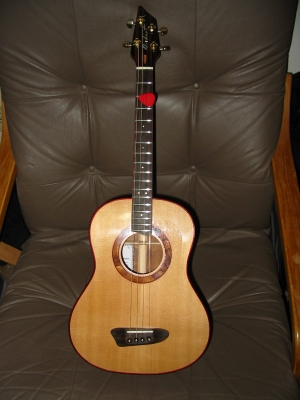 |
 |
 |
Then
there is this Ukulele. It is an X-braced steel strung cannon -
crystal clear to the highest fret, and with amazing sustain. Steel
makes the note attack crisp, with a bright tone. Steel strings
distort less during playing allowing for much better intonation, along
with a very low action for faster playing. To
accommodate steel strings, the design of this instrument departs form
standard in a number of ways. In addition to the internal X-bracing,
changes include the bridge to allow bridge pins, a bridge plate inside
under the Solid Sitka top, an intonated bone saddle, and an adjustable
truss rod inside the neck.
|
 |
| The
steel strings also require enough tension to make them responsive, that
means tuning them up in pitch. With an 18.5" scale length, this
corresponds to about the 6th to 7th fret on a standard sized guitar, or A - D - F# -
B. The sound port on the side of the upper bout improves sound
projection and lets the player really hear the instrument. The
extended fret board goes all the way up to a high E at the 17th
fret. That is another unusual feature, most Ukulele fret boards end
at the body at the 12th fret. |
 |
 |
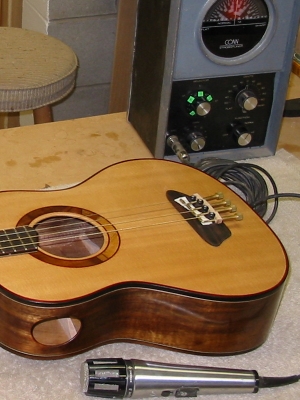 |
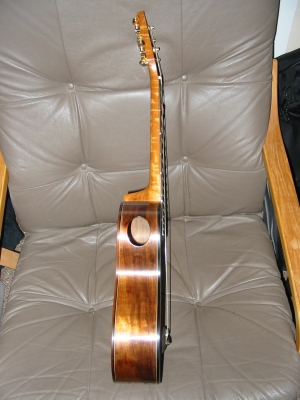 |
The
steel strings may be a radical departure form tradition but the Koa (endemic
to Hawaii) reclaims that a little. Koa is the classic choice for all
forms of Hawaiian guitar family instruments, partly for it's sound, and
partly for the wonderful colour and figure Koa presents.
Click on this icon to see a large format
image of the Ukulele.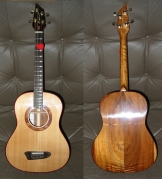 |
| Ok... do I call this instrument a
Ukulele? Or always specify the "Steel String" part of the
name? Or is it just a little 4 string guitar? These two photos
at right don't appear much different from photos of guitars under
construction, and that is the point. The X-brace takes up sound
vibrations, and the load of the steel strings, then distributes these all
across the top, while the back reflects sound pressure out the two sound
holes. There is so much liveliness to this instrument that touching
the back when played feels just like touching a speaker cabinet when sound
is being produced. |
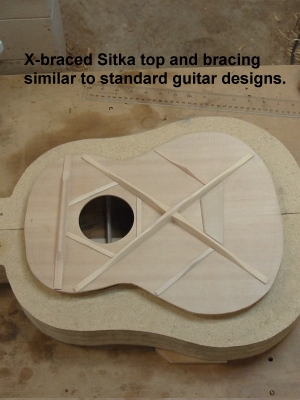 |
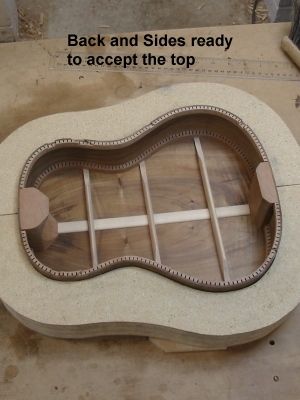 |
| Top |
Sitka Spruce |
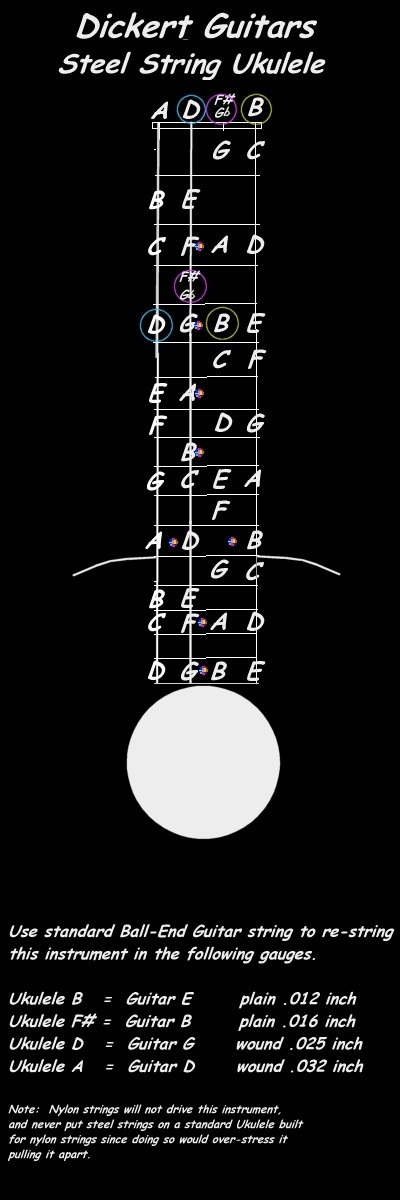
|
| Rosette |
Koa |
| Bracing |
X-braced Sitka Spruce |
| Back and sides |
Koa |
| Body Binding |
Macassar Ebony |
| Purfling |
Red/Black/Red |
| End graft |
Macassar Ebony |
| Heal and Tail Blocks |
Honduras Mahogany |
| Kerfed Lining |
Mahogany |
| Neck |
Two peace Flame African
Mahogany with a maple
pin line down the middle. |
| Head Cap |
Macassar Ebony |
| Head Inlay |
"Dickert" in Mother
of Pearl |
| Truss Rod |
Twin rod two-way adjustable at head |
| Fret Board |
Macassar Ebony |
| Position Marks |
Mother of Pearl 3mm Dot Position
marks on the top surface and 2mm at the side. |
| Fret Board Binding |
Macassar Ebony with side Maple pin
line and top Red pin line. |
| Bridge |
Macassar Ebony |
| Bridge pins |
Ebony with Mother of Pearl Dots |
| Bridge Saddle |
Bone, compensated for intonation,
graduated for string thickness |
| Nut |
Bone, Graduated for string
thickness |
| End pin |
Ebony with Mother of Pearl
dot |
| Tuners |
Grover Mini 2 plus 2 |
| Finish |
French Polished Shellac |

Back

|
![]()
![]()